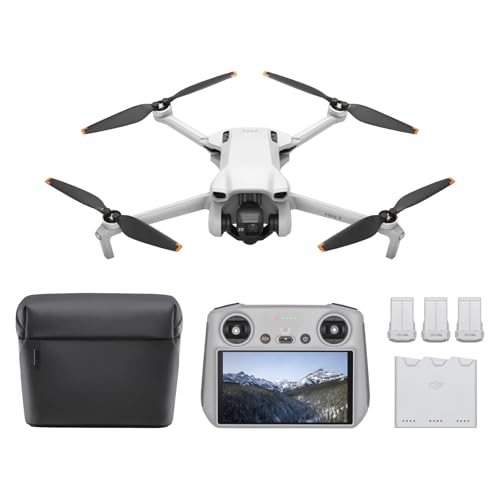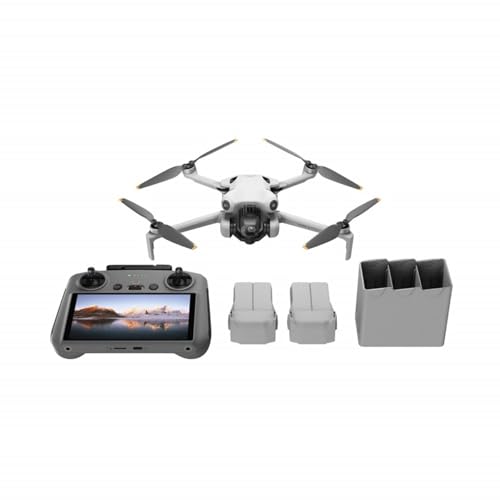Thinking about taking your photography to new heights? A drone can literally elevate your perspective, capturing breathtaking aerial shots that are simply impossible from the ground. When it comes to reliable, high-quality camera drones, DJI is often the first name that comes to mind, and for good reason! They’ve consistently pushed the boundaries of aerial imaging technology, making professional-grade aerial photography accessible to everyone.
But with so many fantastic options out there, how do you pick the best DJI drone for pictures? We know it can be a bit overwhelming, so we’ve done the legwork for you. We’re diving deep into five top DJI drones, focusing on their camera capabilities, stability, ease of use, and overall value for capturing stunning images. Whether you’re a seasoned photographer looking to add a new dimension to your portfolio or a beginner eager to snap some incredible vacation photos, we’ve got a DJI drone for you!
How We Chose the Best DJI Drones for Pictures
When evaluating these drones, we paid close attention to several key factors that make a drone truly exceptional for photography:
- Camera Quality: Resolution (4K UHD), sensor size, and the ability to capture detail in various lighting conditions.
- Gimbal Stabilization: A crucial component for smooth, shake-free photos and videos.
- Flight Performance & Stability: How well the drone handles wind and maintains its position, which directly impacts image quality.
- Battery Life: More flight time means more opportunities to get that perfect shot.
- Portability: How easy it is to carry your drone to different locations.
- Ease of Use: Features like GPS Return to Home and QuickShots make flying and shooting simpler, especially for beginners.
Let’s soar into our top picks!
DJI Mini 4K Camera Drone Combo

The DJI Mini 4K Camera Drone Combo is an incredible entry point for anyone looking to get into aerial photography without breaking the bank or worrying about complex regulations. Weighing under 249g, this drone often doesn’t require FAA registration for recreational use, making it incredibly appealing. But don’t let its mini size fool you; it packs a punch with its 4K UHD camera and a 3-axis gimbal, delivering crisp, stable images and cinematic footage, even in challenging light. This particular combo provides a good starting point with two batteries, offering extended flight time for more photo opportunities.
Key Features:
– No Registration Needed (Under 249 g)
– 4K Ultra HD & 3-Axis Gimbal for Cinematic Quality Shooting
– 38kph (Level 5) Wind Resistant
– 10km Max HD Video Transmission
– Uninterrupted Creation with Extended Battery Life (62-min with 2 batteries)
– Beginner-Friendly and Safe (One-tap takeoff/landing, GPS Return to Home)
– Boost Your Inspiration with Intelligent QuickShots
– Includes 2 batteries, remote controller, shoulder bag, and more
Pros:
– Excellent image and video quality for its size and price point
– Lightweight and portable, ideal for travel
– Stable flight performance even in moderate winds
– Extended transmission range allows for greater exploration
– User-friendly for beginners
– Comes with essential accessories for immediate use
Cons:
– Lacks advanced obstacle avoidance found in higher-end models
– DJI Fly app download needs to be done via DJI’s official website (not Google Play)
– Battery life, while decent with two batteries, might still feel limiting for longer sessions
User Impressions:
Users frequently praise the Mini 4K for its impressive camera quality and stability, especially considering its compact form factor and price. Many beginners find it incredibly easy to fly and appreciate the cinematic results it produces. The included accessories in this combo make it a great value, allowing for more flight time and convenience right out of the box.
DJI Mini 4K, Drone with 4K UHD Camera for Adults (Single Battery)

This version of the DJI Mini 4K offers the same fantastic camera and flight performance as the combo above, but with a single battery. It’s truly one of the best DJI drone for pictures if you’re on a tighter budget or just dipping your toes into drone photography. You still get that beautiful 4K Ultra HD resolution and the rock-solid stability of a 3-axis gimbal, ensuring your aerial photography looks professional. It’s a fantastic choice for casual photographers or those who want to experience DJI quality without a significant initial investment.
Key Features:
– No Registration Needed (Under 249 g)
– 4K Ultra HD & 3-Axis Gimbal for Cinematic Quality Shooting
– 38kph (Level 5) Wind Resistant
– Uninterrupted Creation with Extended Battery Life (31-min with 1 battery)
– Beginner-Friendly and Safe
– Boost Your Inspiration with Intelligent QuickShots
– Includes 1 battery, RC-N1C remote controller, and necessary accessories
Pros:
– Most affordable entry point for a 4K DJI drone
– Compact and ultra-light, easy to carry everywhere
– Captures high-quality 4K photos and videos
– Intuitive controls make it perfect for new pilots
– Stable flight despite its small size
Cons:
– Single battery limits flight time significantly (around 31 minutes)
– No included shoulder bag or extra propellers in this basic package
– DJI Fly app download workaround required for Android users
User Impressions:
Customers love this version for its sheer affordability and the high-quality images it produces. It’s often highlighted as an ideal starter drone. While some users wish it came with more batteries, they generally agree that it offers incredible value and is perfect for capturing those quick, stunning shots without much fuss.
DJI Mini 4K Fly More Combo, Drone with 4K UHD

For those serious about maximizing their aerial photography sessions without moving up to a larger, more expensive drone, the DJI Mini 4K Fly More Combo is an absolute game-changer. It leverages the same excellent 4K UHD camera and 3-axis gimbal as the other Mini 4K models but supercharges your flight time with three batteries, a two-way charging hub, and a shoulder bag. This means you can spend more time capturing beautiful landscapes, family moments, or dynamic cityscapes, making it an undeniable contender for the best DJI drone for pictures in the ultra-portable category.
Key Features:
– No Registration Needed (Under 249 g)
– 4K Ultra HD & 3-Axis Gimbal for Cinematic Quality Shooting
– 38kph (Level 5) Wind Resistant
– 10km Max HD Video Transmission
– Uninterrupted Creation with Extended Battery Life (93-min with 3 batteries)
– Beginner-Friendly and Safe
– Boost Your Inspiration with Intelligent QuickShots
– Includes 3 batteries, two-way charging hub, shoulder bag, and more
Pros:
– Significantly extended flight time for prolonged shooting sessions
– Comprehensive bundle offers great value for avid photographers
– Lightweight design avoids most registration requirements
– High-quality 4K imagery and stable footage
– Excellent wind resistance for its class
Cons:
– Still lacks advanced obstacle avoidance sensors
– DJI Fly app platform compatibility issue might be a minor inconvenience
– While a great value, it’s the priciest of the Mini 4K variations
User Impressions:
This combo receives widespread acclaim for its incredible value, with users often stating it’s the “only way to buy” a Mini 4K due to the enhanced flight time. Photographers especially appreciate the extra batteries and charging hub, which allow them to capture far more content on a single outing without battery anxiety. The convenience of the shoulder bag is also frequently mentioned.
DJI Avata 2 Fly More Combo (3 Batteries), FPV Drones

Stepping into a different realm of aerial imaging, the DJI Avata 2 Fly More Combo isn’t just about static shots; it’s about adrenaline-pumping, immersive visual storytelling. This FPV (First-Person View) drone offers a unique perspective that traditional camera drones can’t quite match. With its 155° FOV (Field of View) and super-wide 4K footage at 60fps (and even 100fps slow-motion), it excels at capturing dynamic, close-up, and action-oriented pictures and videos. If your idea of the best DJI drone for pictures involves extreme angles, rapid maneuvers, and a truly immersive feel, the Avata 2 is in a league of its own.
Key Features:
– Unlock Adrenaline-Pumping Immersive Flying with Goggles
– Intuitive Motion Control (DJI RC Motion 3 included)
– Easy ACRO for cinematic flips and rolls
– Tight Shots in Super-Wide 4K (155° FOV, 1/1.3-inch image sensor, 4K/60fps)
– Built-in Propeller Guard for Safety and Durability
– Hassle-Free POV Content, Filmmaking at launch (LightCut app integration)
– FAA Remote ID Compliant
– Includes 3 Intelligent Batteries, DJI RC Motion 3, DJI Goggles 3, and more
Pros:
– Unrivaled immersive flight and unique POV image capture
– Incredibly durable with built-in propeller guards
– Motion control makes flying intuitive, even for FPV beginners
– Excellent 4K video and still image quality for dynamic shots
– Comprehensive Fly More Combo with Goggles and Motion Controller for a full experience
– Quick and easy acro moves for dramatic shots
Cons:
– Not ideal for traditional, slow, high-altitude landscape photography
– FPV flying has a steeper learning curve than traditional drones, despite motion control
– More expensive than the Mini series
– Requires FAA Remote ID compliance and registration
User Impressions:
Pilots are absolutely thrilled with the Avata 2’s immersive experience and the incredible, dynamic footage it can capture. The motion controller is a revelation for making FPV flying accessible, and the durability provides peace of mind. While some note the learning curve for truly mastering FPV, the general consensus is that it offers an exhilarating new way to capture incredible visual content.
DJI Mini 3 (DJI RC), Lightweight 3x Mechanical Gimbal

The DJI Mini 3 with the DJI RC controller is a highly capable and user-friendly drone that really shines for photography enthusiasts. It strikes a fantastic balance between portability, advanced camera features, and ease of use. What truly makes it stand out for pictures is its 4K HDR video capabilities, Dual Native ISO Fusion for excellent low-light performance, and the unique True Vertical Shooting mode – perfect for social media content. Combined with the integrated screen of the DJI RC, it offers a streamlined and incredibly enjoyable aerial photography experience, positioning it as a top contender for the best DJI drone for pictures in its class.
Key Features:
– No Registration Needed (Under 249 g)
– 4K UHD Stunning Imagery with HDR Video & Dual Native ISO Fusion
– Striking Vertical Videos Ready to Share (True Vertical Shooting)
– Extended Battery Life (Up to 51 mins with Intelligent Flight Battery Plus, sold separately)
– 38kph (Level 5) Wind Resistant and 3-Axis Gimbal
– 10km Max HD Video Transmission
– Creative Features for Advanced Shots (QuickShots, Panorama)
– Beginner-Friendly and Safe
– QuickTransfer via Wi-Fi for fast downloads
– Includes the DJI RC with built-in 5.5-inch HD display
Pros:
– Exceptional image quality with 4K HDR and improved low-light performance
– True Vertical Shooting is a game-changer for social media
– DJI RC controller with built-in screen provides a superior flying experience
– Very stable with excellent wind resistance
– Lightweight and portable, often avoiding registration
– Excellent battery life, especially with the Intelligent Flight Battery Plus
Cons:
– Intelligent Flight Battery Plus increases weight above 249g (requiring registration)
– Lacks obstacle avoidance sensors (compared to Mini 3 Pro)
– No tracking features (like ActiveTrack)
– DJI RC version is more expensive than standard controller bundles
User Impressions:
Users are consistently impressed with the Mini 3’s camera capabilities, particularly the HDR video and the innovative vertical shooting mode. The DJI RC is a major highlight, simplifying the setup and enhancing the overall flying experience with its bright, integrated display. Many consider it a superb upgrade for photographers looking for an excellent balance of features and portability.
Buyer’s Guide: What to Look For in the Best DJI Drone for Pictures
Choosing the perfect drone for your aerial photography needs involves more than just picking a cool-looking gadget. Here’s a quick guide to help you decide:
-
Camera Quality is King:
- Resolution: Aim for at least 4K UHD for sharp, detailed photos and videos.
- Sensor Size: A larger sensor (e.g., 1/1.3-inch) generally means better low-light performance and dynamic range, resulting in richer images.
- HDR (High Dynamic Range): Essential for capturing detail in both bright highlights and deep shadows.
- True Vertical Shooting: A huge plus if you plan to share content on social media platforms like TikTok or Instagram Stories.
-
Gimbal Stabilization:
- A 3-axis mechanical gimbal is crucial. It keeps the camera perfectly stable, even when the drone is moving or battling wind, ensuring your photos are crisp and blur-free.
-
Flight Time & Batteries:
- More flight time equals more opportunities for the perfect shot. Look for drones offering 30+ minutes per battery. Consider “Fly More” combos that include multiple batteries and charging hubs.
-
Portability & Weight:
- If you plan to travel with your drone, size and weight matter. Drones under 250g often don’t require FAA registration, offering more freedom.
-
Ease of Use & Intelligent Features:
- Beginner-Friendly Controls: Features like one-tap takeoff/landing, GPS Return to Home (RTH), and stable hovering are essential for new pilots.
- QuickShots & Intelligent Flight Modes: Pre-programmed cinematic maneuvers can help you capture professional-looking videos with minimal effort.
- Integrated Remote Controller: Remotes like the DJI RC with built-in screens simplify your setup and improve visibility in bright conditions.
-
Wind Resistance:
- A drone with good wind resistance (e.g., Level 5) will maintain stability better, leading to clearer photos, especially in open environments.
Conclusion
Finding the best DJI drone for pictures really comes down to your specific needs, skill level, and budget. For incredible value, portability, and excellent 4K imagery, any of the DJI Mini 4K variations are stellar choices, with the Fly More Combo offering the most photographic potential due to extended flight time. If you crave a more immersive, dynamic, and action-oriented perspective, the DJI Avata 2 is an unparalleled choice for unique visual storytelling. And for a fantastic balance of advanced camera features like HDR and True Vertical Shooting with a premium user experience, the DJI Mini 3 with the DJI RC stands out.
No matter which you choose, you’re investing in DJI’s renowned quality and innovation. So go ahead, pick your favorite, and start capturing those breathtaking moments from above!
FAQ Section
Q1: Do I need to register my DJI drone for recreational use?
A1: It depends on the drone’s weight. Drones under 250 grams (like most DJI Mini series drones, when equipped with standard batteries) generally do not require FAA registration or a Remote ID for recreational use in the US. However, always check the latest local regulations and the FAA’s official website, as rules can change and vary by region. If you use a larger battery that makes your Mini drone exceed 250g, or if you fly for commercial purposes, registration will be required.
Q2: What’s the main difference between the DJI Mini 4K and DJI Mini 3?
A2: While both are excellent compact drones, the Mini 3 offers several upgrades, including 4K HDR video, Dual Native ISO Fusion for better low-light performance, and the unique True Vertical Shooting feature. The Mini 3 also supports longer flight times with an optional Intelligent Flight Battery Plus. The Mini 4K is a more budget-friendly option that still delivers impressive 4K resolution.
Q3: Is a 3-axis gimbal really important for drone photography?
A3: Absolutely! A 3-axis mechanical gimbal is critical for capturing smooth, stable, and professional-looking photos and videos. It physically counteracts the drone’s movements (pitch, roll, and yaw) in real-time, preventing shaky or blurry shots, especially during flight maneuvers or in windy conditions. Without it, your footage would likely be unwatchable.
Q4: How long do DJI drone batteries typically last, and what’s a “Fly More Combo”?
A4: DJI drone batteries typically offer between 20 to 45 minutes of flight time, depending on the model and flight conditions. A “Fly More Combo” (or similar bundles) is a package offered by DJI that usually includes the drone, multiple extra batteries (often 2 or 3), a multi-battery charging hub, spare propellers, and sometimes a carrying bag. These combos are highly recommended as they significantly extend your total flight time for longer shooting sessions.
Q5: Can I fly these drones at night for night photography?
A5: While many DJI drones can technically fly at night, capturing high-quality night photography requires specific camera capabilities (like good low-light performance and larger sensors, e.g., Mini 3’s Dual Native ISO). Additionally, flying drones at night may have specific local regulations and require proper lighting on the drone for visibility. Always check local laws and FAA guidelines regarding night operations.
Q6: What does “FPV” mean in the context of the DJI Avata 2?
A6: FPV stands for “First-Person View.” In the case of the DJI Avata 2, it means you experience flying the drone from the perspective of a virtual pilot inside the cockpit, typically through goggles that display a live video feed from the drone’s camera. This offers an incredibly immersive and dynamic flying and photographic experience, allowing for unique, action-oriented shots that differ from traditional aerial photography.
Q7: Do these drones come with a remote controller?
A7: Yes, all the DJI drones reviewed here come with a remote controller. Some, like the DJI Mini 3 (DJI RC), include a more advanced controller with a built-in screen, eliminating the need to use your smartphone. Others come with a standard controller where you attach your smartphone to use as the display and access the DJI Fly app.



